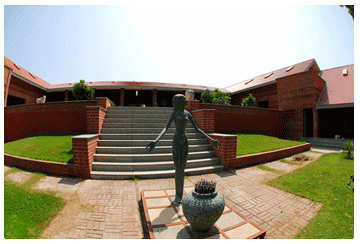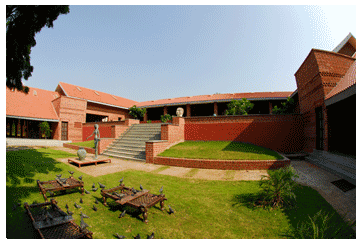- A fresh start
- Guest Editor’s Column
- Cast in Bronze
- The month that was
- Visual Diary
- Nomadic Detours
- Relation Next
- Lightness of being Anxious
- Necklace of Echoes
- The New Order Beauty
- Voyage
- Ribbed Routes
- Museum Talk
- Hard Talk
- Master Stroke
- Market Insight
- Artist Index and Statistics
- Auction Reports
- Creative Impulse
- Mid Century Modern : Retro Furniture
- 14th Kolkata Film Festival
- ABOHOMAN
- In the News
- Photo Feature
- Different hues of Aakriti
ART news & views
Museum Talk
Volume: 2 Issue No: 1 Month: 2 Year: 2010
Normally, visits to the museums top the itinerary list when one is travelling overseas. Some of the famed museums abroad include the Louvre in Paris, Victoria & Albert and National Gallery in London, British Museum, Museum of Modern Art in New York, National Gallery of Art in Washington DC, the Van Gogh and Rembrandt museums in Amsterdam, Prado in Madrid and Florence Museum. The list of these repositories of objets d'art is virtually endless.
Back in India, the few government museums don't enjoy that popularity and glamour. Neither are they armed with adequate funds to spruce up or add to their collections. Whether it's the National Museums in Delhi and Kolkata or Delhi's National Gallery of Modern Art. In fact, they are also known to acquire from auctions. Of late, a trend is perceptible where private initiatives are taking off to boost the museum infrastructure in India.
Kiran Nadar Museum of Art
The Kiran Nadar Museum of Art (KNMA), which has kicked off recently, is one such major project. Sponsored by the Shiv Nadar Foundation, the non-commercial and not-for-profit KNMA is at present housed at HCL Technologies in Noida, UP. Spreading over 13,000 sq ft, the museum will grow to its full-fledged proposed size of 80,000 sq ft over the next two years. Incidentally, the foundation was established by Shiv Nadar, the founder of HCL.
KNMA will be museum space for exhibiting Modern and Contemporary art from India and the subcontinent. It will also engage in artist's residencies/scholarships/art projects, facilitating art appreciation projects and research related to art and culture.
Uttarayan Art Foundation
Baroda-based businessman Rakesh Agrawal, a chemical engineer by profession, has been passionately lapping up art for the last 15 years. Over these years, he has built up a collection of roughly 2,500 works.  Agrawal, who has formed the Uttarayan Art Foundation (UAF), has already acquired a 50-acre land on the riverfront. Of this, they have developed 12 acres. The UAF was launched 2 years back. Artists are invited to practise various forms of art in the present complex. Over the last two years, over 150 artists, including 35 international names, have dropped by and worked here.
Agrawal, who has formed the Uttarayan Art Foundation (UAF), has already acquired a 50-acre land on the riverfront. Of this, they have developed 12 acres. The UAF was launched 2 years back. Artists are invited to practise various forms of art in the present complex. Over the last two years, over 150 artists, including 35 international names, have dropped by and worked here.
The museum, which will occupy around 60,000 sq ft, will be a standalone structure and will be a closed building. It is tipped to start in 2011 and end in 2012.They are still to come up with a name for the museum.
Kolkata Museum of Modern Art
KMoMA- The Kolkata Museum of Modern Art is probably one of the most ambitious art projects taken up in the eastern fringes of India.The trustee board of KMoMA includes Rakhi Sarkar, Chief minister Buddhadeb Bhattacharjee, reputed artist Jogen Choudhury and others. KMoMA has already acquired a 10-acre plot in Rajarhat where the museum will be constructed spanning over 3 lakh sq ft. The place would also consist of an auditorium, open-air theatre, a courtyard, guest houses and display spaces. The museum will display modern and contemporary art from the national scenario, works by Bengal School masters, miniatures and international pieces from countries like Southeast Asia, China and Japan. Herzog and De Meuron are the architects who would design the KMoMA. The Tate Modern Museum was also redesigned and renovated by them. The total project investment will amount to Rs 400-500 crore. KMoMA have already risen about Rs 150 crore, with Rs 135 crore coming from the state. They have also approached the Centre for a tranche of Rs 150 crore, which is under consideration. The museum is slated to come up in the next 3-4 years.Choudhury and others. KMoMA has already acquired a 10-acre plot in Rajarhat where the museum will be constructed spanning over 3 lakh sq ft. The place would also consist of an auditorium, open-air theatre, a courtyard, guest houses and display spaces. The museum will display modern and contemporary art from the national scenario, works by Bengal School masters, miniatures and international pieces from countries like Southeast Asia, China and Japan. Herzog and De Meuron are the architects who would design the KMoMA. The Tate Modern Museum was also redesigned and renovated by them. The total project investment will amount to Rs 400-500 crore. KMoMA have already risen about Rs 150 crore, with Rs 135 crore coming from the state. They have also approached the Centre for a tranche of Rs 150 crore, which is under consideration. The museum is slated to come up in the next 3-4 years.
Emami Museum
Kolkata-headquartered Emami group is also on its way to put up a museum. Being set up by Emami Foundation, headed by Mr R S Agarwal and Mr R S Goenka, the institution will operate under Emami Chisel Art. Emami Chisel is collaboration between Emami and Chisel Art and is led by Vikram Bachhawat of Chisel Art and Richa Agarwal of the Emami group. They have been collecting Modern and Contemporary paintings and artworks for quite a while now.  Their collections would be running into around 2,500-3,000 works. They have acquired a plot behind Emami Towers complex on the EM Bypass to build an 8-storeyed museum. The museum will embrace paintings, sculptures, textiles, Rajasthani paintings on silver and gold, Dokra works, iron and steel sculptures, traditional handicraft and gems and jewellery, among a gamut of artworks. There will also be a space for poor artisans to create their ware. The museum is envisaged to boast of Rs 100-125 crore outlay. Mohit Gujral, son of renowned artist Satish Gujral, is the architect of the Emami museum, which is still to be given a formal name.
Their collections would be running into around 2,500-3,000 works. They have acquired a plot behind Emami Towers complex on the EM Bypass to build an 8-storeyed museum. The museum will embrace paintings, sculptures, textiles, Rajasthani paintings on silver and gold, Dokra works, iron and steel sculptures, traditional handicraft and gems and jewellery, among a gamut of artworks. There will also be a space for poor artisans to create their ware. The museum is envisaged to boast of Rs 100-125 crore outlay. Mohit Gujral, son of renowned artist Satish Gujral, is the architect of the Emami museum, which is still to be given a formal name.
Ahuja Museum for Arts
The Ahuja Museum for Arts was inaugurated on 8th November 2009. Honourable Mr. Justice Aniruddha Bose graced the occasion and Ms. Nayantara Palchoudhuri, Former President - Bengal National Chamber Of Commerce & Industry and Honorary Consul of Norway was the guest of honour on that occassion. The inaugural exhibition showcased Asian Art from 8 November 2009 to 30 November 2009. The museum would also display the personal collections of Sudhir D. Ahuja. The collection includes 1000 works collected by him from India, Asia and other countries. 50 works would be displayed at a time in the gallery.
If all these new ventures turn out to be a success in the Indian context, then the invaluable art works created by our masters and those which are to be created in the future will have better places to get preserved, restored and curated.